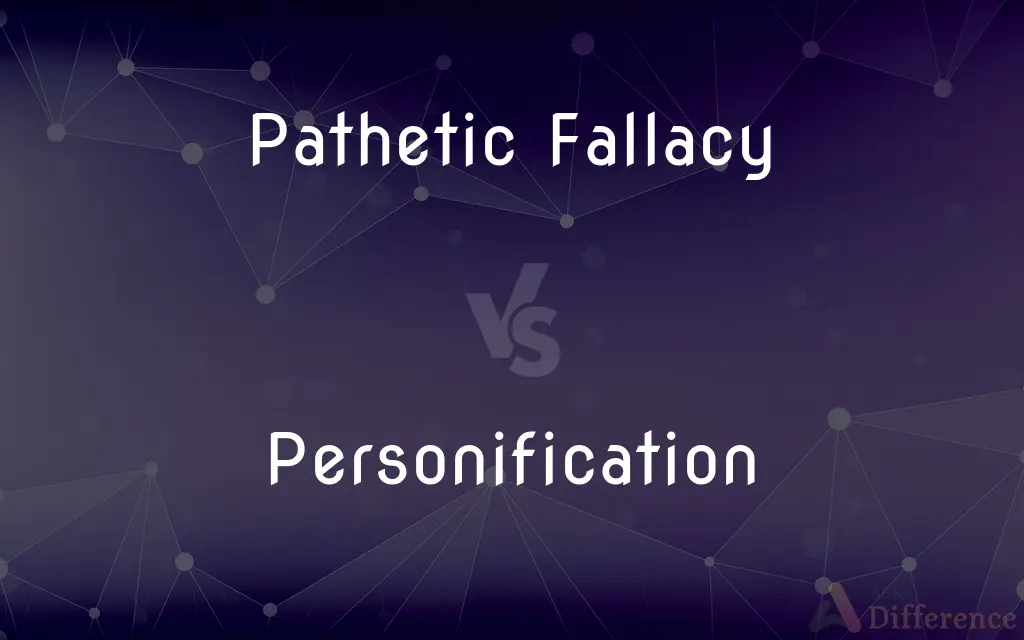Pathetic Fallacy vs. Personification — What's the Difference?
By Tayyaba Rehman — Published on December 17, 2023
Pathetic Fallacy attributes human emotions to nature or inanimate objects; Personification gives human qualities or actions to non-human entities.

Difference Between Pathetic Fallacy and Personification
Table of Contents
ADVERTISEMENT
Key Differences
Pathetic Fallacy and Personification are both literary devices, but they serve different purposes. Pathetic Fallacy is a specific form of Personification where nature or inanimate objects are described as having human emotions. For instance, if the weather in a story mirrors a character's mood, like a thunderstorm during a tragic event, that's a use of Pathetic Fallacy.
On the other hand, Personification is a broader term. It involves giving human characteristics, actions, or emotions to something that isn't human. While Pathetic Fallacy deals specifically with emotions, Personification can be about any human-like quality. For example, saying "the wind whispered" is using Personification because the wind, a non-human entity, is given a human action (whispering).
When considering Pathetic Fallacy, it's essential to understand its emotional emphasis. It's more than just giving human attributes; it's about assigning human feelings to the environment, often to reflect or emphasize a character's emotions. If the trees "mourn" the loss of summer, it's a Pathetic Fallacy because trees are given a human emotion (mourning).
In contrast, Personification can be more neutral or versatile in its application. It doesn't always carry emotional weight. For instance, "the clock hands raced" is a Personification, assigning a human action (racing) to clock hands, but it's not necessarily emotional in the way Pathetic Fallacy is.
Comparison Chart
Main Focus
Human emotions attributed to nature/inanimate objects
Human qualities/actions given to non-human entities
ADVERTISEMENT
Scope
Specific to emotions
Broader, includes any human characteristic
Emotional Weight
Often used to mirror/reflect human emotions
Can be neutral or emotional
Examples
Rain during a sad scene
The sun smiled down
Usage in Literature
To evoke atmosphere or emphasize character feelings
To bring vividness to descriptions
Compare with Definitions
Pathetic Fallacy
A literary device attributing human emotions to nature.
The gloomy clouds seemed to share her sorrow.
Personification
Attributing human-like qualities to abstracts.
Love never fails.
Pathetic Fallacy
Nature mirroring the emotions of characters.
The storm raged on, as did his anger.
Personification
Making objects or ideas appear human-like.
Time waits for no one.
Pathetic Fallacy
Using nature to emphasize or reflect moods.
The sunset celebrated their newfound love.
Personification
Assigning human traits to non-human entities.
The stars danced in the night sky.
Pathetic Fallacy
Nature expressing human-like sentiments.
The mountains stood defiant against time.
Personification
Giving human actions to inanimate objects.
The curtains whispered secrets.
Pathetic Fallacy
Assigning feelings to the environment.
The trees mourned the loss of autumn leaves.
Personification
The act of personifying.
Personification
A person or thing typifying a certain quality or idea; an embodiment or exemplification
"He's invisible, a walking personification of the Negative" (Ralph Ellison).
Personification
A figure of speech in which inanimate objects or abstractions are endowed with human qualities or are represented as possessing human form, as in Hunger sat shivering on the road or Flowers danced about the lawn. Also called prosopopeia.
Personification
Artistic representation of an abstract quality or idea as a person.
Personification
A person, thing or name typifying a certain quality or idea; an embodiment or exemplification.
Adolf Hitler was the personification of anti-Semitism.
Personification
A literary device in which an inanimate object or an idea is given human qualities.
The writer used personification to convey her ideas.
Personification
An artistic representation of an abstract quality as a human
The Grim Reaper is a personification of death.
Personification
The act of personifying; impersonation; embodiment.
Personification
A figure of speech in which an inanimate object or abstract idea is represented as animated, or endowed with personality; prosopop ia; as, the floods clap their hands.
Personification
A person who represents an abstract quality;
She is the personification of optimism
Personification
Representing an abstract quality or idea as a person or creature
Personification
The act of attributing human characteristics to abstract ideas etc.
Personification
Describing non-humans with human characteristics.
The brave little toaster faced its challenges.
Common Curiosities
Can Pathetic Fallacy be used with objects other than nature?
Traditionally, Pathetic Fallacy is used with nature, but it can be applied to inanimate objects to reflect human emotions.
Is Pathetic Fallacy a type of Personification?
Yes, Pathetic Fallacy is a specific form of Personification focused on emotions.
Is every instance of Personification also a Pathetic Fallacy?
No, only those instances of Personification that attribute human emotions specifically are considered Pathetic Fallacy.
Why use Personification in writing?
Personification can make descriptions more vivid and relatable.
Are there limits to how Pathetic Fallacy can be used?
While there's creative freedom, excessive use might make a narrative feel overly dramatic.
What's the emotional significance of Pathetic Fallacy?
Pathetic Fallacy often emphasizes or mirrors the emotions of characters.
How does Pathetic Fallacy enhance literature?
Pathetic Fallacy can set mood, tone, or atmosphere and mirror characters' emotions.
Does Personification always need to be emotional?
No, Personification can simply provide vivid imagery without emotional context.
Can Personification be applied to abstract concepts?
Yes, concepts like time or love can be personified.
How does Pathetic Fallacy differ in poetry and prose?
In both, it sets mood and tone, but in poetry, it might also contribute to rhythm and rhyme.
Why is it called "Pathetic" Fallacy?
"Pathetic" comes from "pathos," meaning emotion. It's about attributing feelings, not being "pathetic" in the modern sense.
Is Personification common in children's stories?
Yes, it's often used to make inanimate objects or animals relatable to children.
Is Pathetic Fallacy only negative emotions?
No, any emotion, positive or negative, can be reflected through Pathetic Fallacy.
Can Personification be humorous?
Yes, giving human traits to non-human things can sometimes be comedic.
Can animals be subject to Personification?
Yes, animals can be described with human traits or emotions.
Share Your Discovery

Previous Comparison
Tatkal vs. Premium Tatkal
Next Comparison
Excitation Potential vs. Ionization PotentialAuthor Spotlight
Written by
Tayyaba RehmanTayyaba Rehman is a distinguished writer, currently serving as a primary contributor to askdifference.com. As a researcher in semantics and etymology, Tayyaba's passion for the complexity of languages and their distinctions has found a perfect home on the platform. Tayyaba delves into the intricacies of language, distinguishing between commonly confused words and phrases, thereby providing clarity for readers worldwide.













































